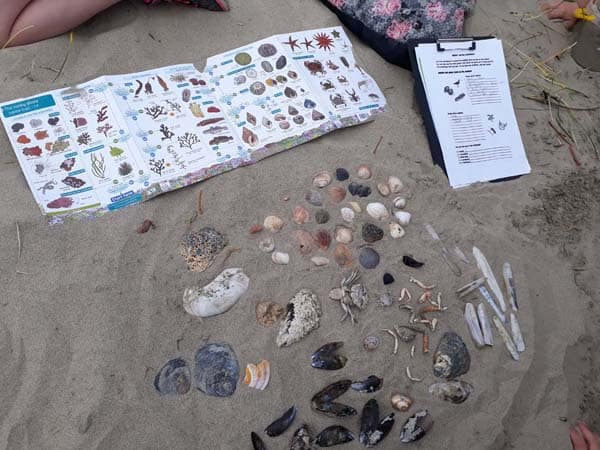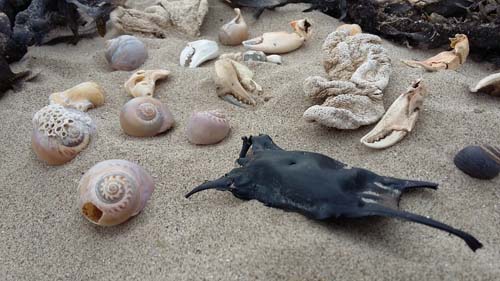
Many of us have enjoyed a stroll along a beautiful beach at some stage and we all have stories about the interesting things that we’ve found. In fact, the seashore is a great place to start learning about life in our oceans! A short walk along the wrack line can provide us with clues as to what’s living in the sea close by.
Natural things commonly found washed up on the beach include:
- Seashells
- Cuttlefish bones
- Dead coral
- Jellyfish
- Starfish and sea stars
- Eggs and eggcases
- Seaweed
- Fish
- Seabirds
- Sea turtles and
- Marine mammals (whales, dolphins, porpoises and seals)
Seashells
Where do seashells come from?
Many groups of animals in the ocean have a tough shell, or exoskeleton, which helps to protect them from predators and wave action. When these animals die, or moult (the process of shedding the shell in order to grow bigger), the shell is left behind and is sometimes washed up on the shoreline.
So when you find a shell on the beach, you are actually finding the dead or discarded remains of a sea creature!
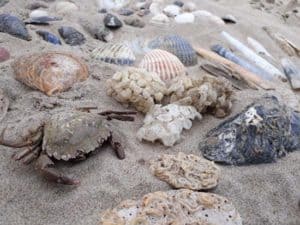
What kind of seashells can we find on the seashore?
There are some groups of shelled sea animals that you are more likely to encounter on the seashore and these include:
- Mollusks
- Crustaceans and
- Sea Urchins.
Mollusks are creatures that have a soft body with a muscular foot that is generally surrounded by a tough calcareous exoskeleton or shell. All mollusks have a special fleshy organ called a mantle which allows them to form the shell.
Some mollusks have two shells, eg. clams, cockles, mussels, oysters and scallops. We call these creatures bivalves.
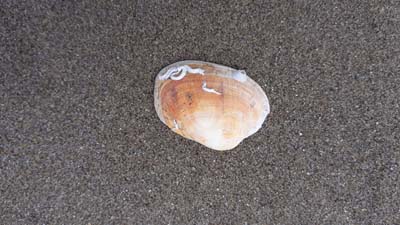
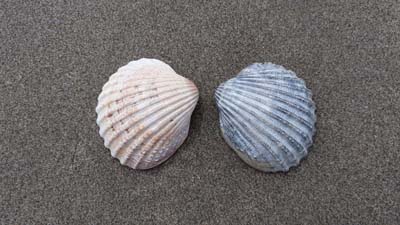
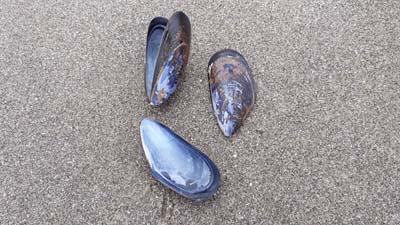
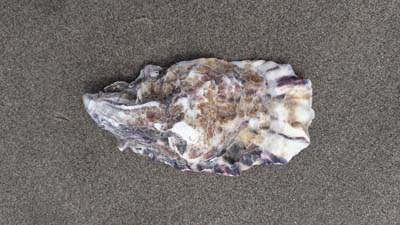
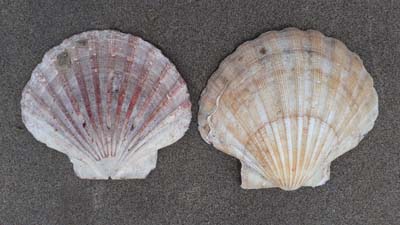
Other mollusks that you may find on the seashore have just one shell, and this includes the sea snails, eg. whelks, conchs, winkles, top shells, cowries and limpets. Scientists call these animals gastropods.
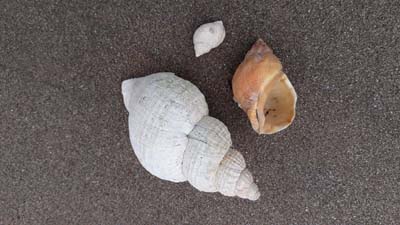
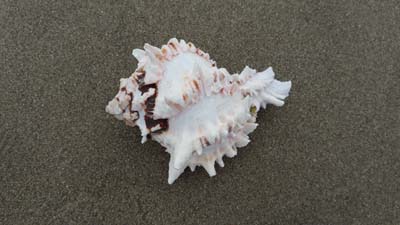
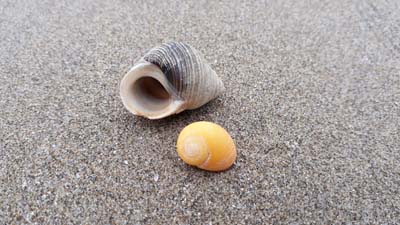
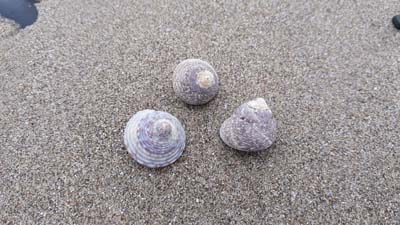
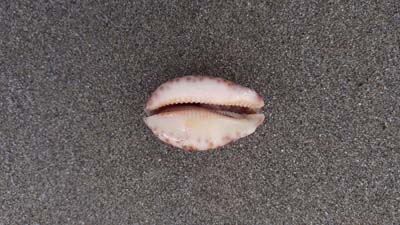
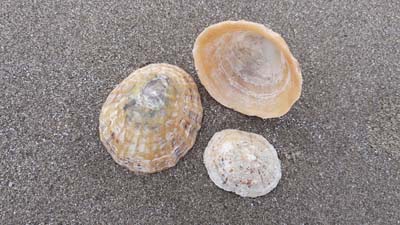
Depending on where you are in the world, you may also find other types of mollusks, eg. chitons and tusk shells.
Crustaceans (pronounced Crust-ay-shuns) are a successful group of shelled animals that have numerous jointed limbs, including claws and pincers. This group includes creatures like crabs, prawns, lobsters and crayfish.
When you are beachcombing you may find the shell that covers the crustacean’s body. This is called the carapace.
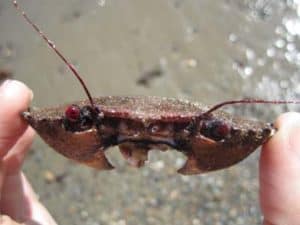
You may also find the animals’ legs or claws.
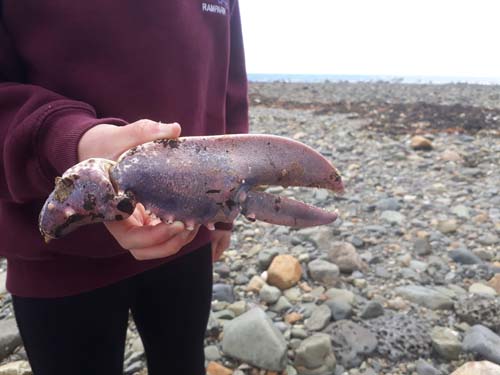
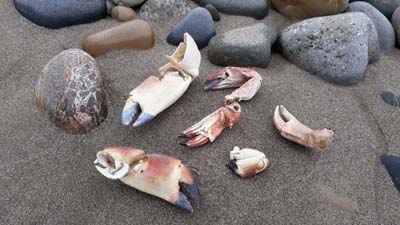
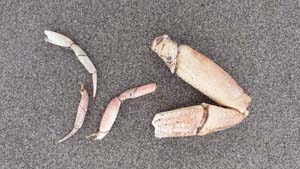
Sea Urchins are a spiny shelled animal that belong to a large group called the Echinoderms (pronounced E-kyno-derms). Their round protective shell, which is also called a test, is covered in little spines that have usually fallen off by the time they have washed up on the shoreline.
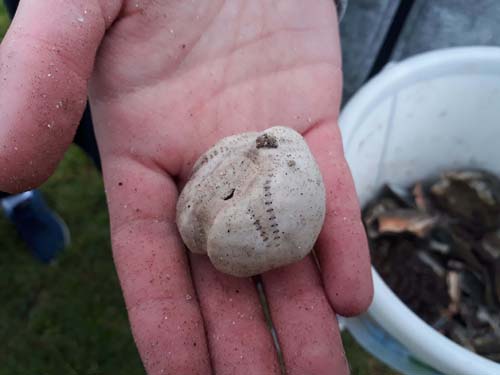
These beautiful shells are also very fragile and may have broken into small fragments before they are discovered by a beachcomber.
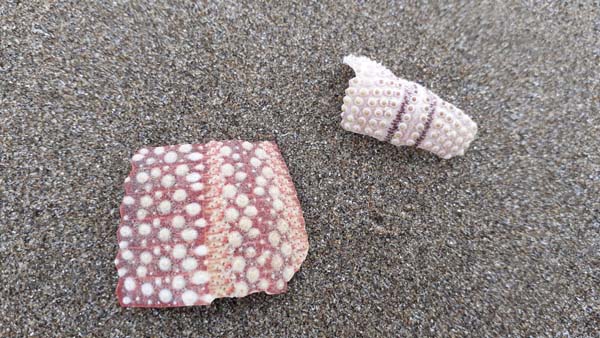
Thousands of different types of shells are washed up on beaches around our planet each year and you will encounter different species depending on where you are beachcombing, but most of these sea animals will belong to one of the groups described above.
If you’d like more help with identifying shells and animals in your area, we recommend that you invest in a field guide.
Cuttlefish Bones
There is one group of mollusks, the Cuttlefish, which possess a very simple internal shell that looks like a bone. This bone-like shell, which is filled with gases, helps the animal to control its buoyancy in the water. This is unlike most other mollusks which use their shell as an exoskeleton.
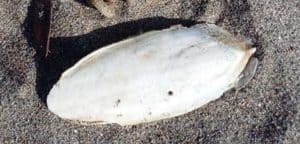
These bones are frequently washed up on beaches after the animal dies and the shape and size of the shell can be used to determine the species. You may also see them for sale in pet shops since the bone is used to help pet birds keep their beaks trim. It can also provide a source of calcium for small pets like chinchillas, tortoises and turtles.
Dead Coral
Corals are primitive animals which have hard exoskeletons that support them as they grow. Although most people are aware of corals living in colorful reefs in tropical countries, few realize that there are also many coral species living in colder waters too. This includes coral reefs growing in the Atlantic and Pacific Oceans off the coasts of Europe, America, Africa and New Zealand.
There are two main types of coral that you may find on the beach, Hard Corals and Soft Corals.
The Hard Corals possess a hard exoskeleton that is made of aragonite, a form of calcium carbonate,
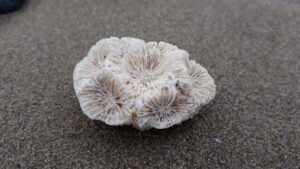
whereas Soft Corals have a softer body which can often feel quite leathery to touch. This is because the tissue in their bodies is strengthened with small needle like structures called sclerites.
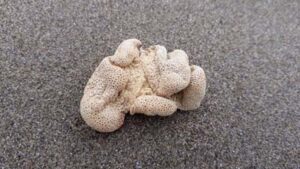
If you find a piece of coral on the beach and look at it closely, you will see that it has lots of little pits and holes on its body. When the animal is alive, each of these little openings protects a polyp, which is the soft part of the coral that is used for feeding.
Although corals are animals, some of them actually use plants called zooxanthellae to make their food. Others catch and consume plankton that drifts in the ocean water column.
Jellyfish
Can a dead jellyfish on the beach still sting you?
Jellyfish are frequently stranded on beaches around the world and it’s important to understand that some species are still able to yield a nasty sting at this point, even though it may seem like the animal is dead. Although it may seem clear that the animal is unable to function properly on land, the stinging capsules in the animal’s tentacles can continue to operate.
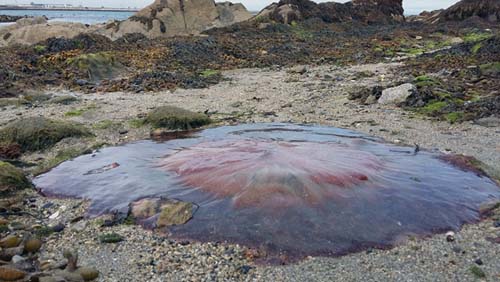
Can you touch a dead jellyfish?
If you find a jellyfish on the beach, it’s best not to touch it. However, if you do get stung, it’s important to know what to do. It’s also useful to be informed about which types of jellyfish sting in your area.
Reporting your sighting to a local citizen science program can also help marine biologists to learn more about jellyfish movement and migration. For example, sightings reported to the The Big Jellyfish Hunt in Ireland have indicated that jellyfish numbers stranded on beaches have been increasing for some species.
Check out the video below to watch some of Ireland’s jellyfish swimming underwater!
Starfish and Sea Stars
If you are beachcombing after a storm, you may come across a stranded starfish or sea star that has got caught in the surf. The animal may have already died, but it’s also not uncommon to find these creatures still alive on the shoreline.
How to know if a starfish is dead or alive:
If a starfish is still alive, you can usually see its little tube feet moving. The animal’s body should also be firm and moist. If you have any doubts as to whether the animal is alive, you should always return it to sea, just in case.
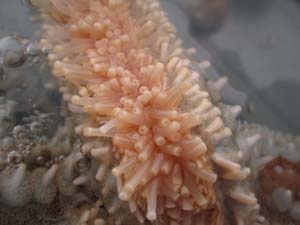
Check out the video below to see what a healthy, active starfish looks like!
You may also find a starfish with one arm that is shorter than the rest. This is because it is growing back an arm that it has most likely lost through an attack from a predator. Starfish have amazing powers of regeneration!
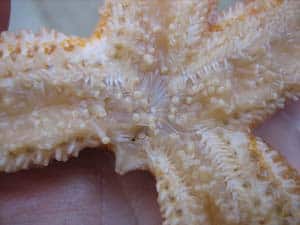
Eggs and Eggcases
Many ocean animals lay eggs with protective casings surrounding them and some of these can be washed up on the shoreline after the young creatures have hatched. You may also find casings that have been stranded on the beach with the egg or embryo still inside.
Eggs and eggcases found on the beach include:
- Shark, Skate and Ray eggcases
- Sea Snail eggs
- Cuttlefish eggs
Shark, skate and ray eggcases (also known as mermaids’ purses) are frequently washed up on shorelines around the world and mermaid’s purse hunting is fast becoming a popular beachcombing activity.
The best place to find a mermaid’s purse is up on the wrack line at the back of the beach and if you find one you can help marine conservation by reporting your sighting to a local shark and ray sightings scheme.
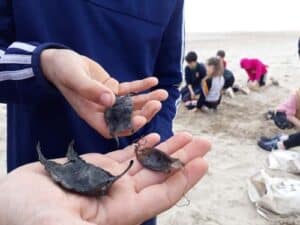
Sea Snail eggs most frequently found on the beach include Whelk eggs, Necklace Shell eggs and Moon Snail eggs.
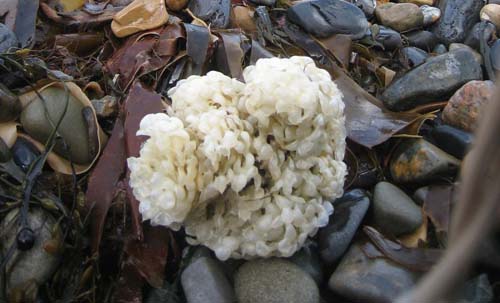
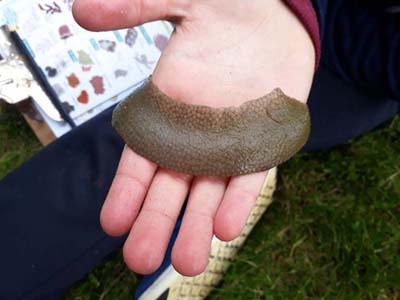
Cuttlefish eggs are also occasionally washed ashore.
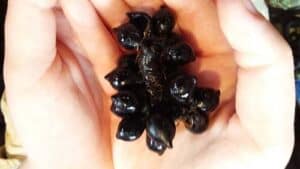
Seaweed
Most of us like to hunt for seashells and coral when we are beachcombing but there are many interesting seaweeds to discover on the shoreline too. These marine plants are very important in the ocean as they provide shelter and food for many sea animals. Some species are also harvested and eaten by people since seaweeds are known to have many health benefits.
There are three main groups of seaweeds that you may find washed up on the strand or wrack line. These are the Green Seaweeds, Brown Seaweeds and Red Seaweeds.
Green Seaweeds often live high up on the shore since they need more light than the brown and red seaweeds to survive. You may also find them washed up on the wrack line.
Some species of green seaweed are eaten by people. For example, Sea Lettuce is used in soups and salads in North America, Japan and Ireland.
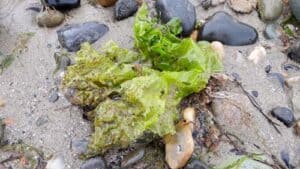
Green seaweed is also important in the diet of some seabirds. For example, Brent Geese migrate thousands of miles from Arctic Canada to feed on the Gutweed that grows on Ireland’s seashore in Europe.
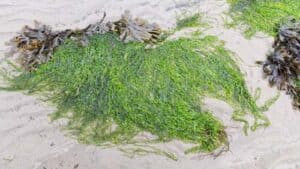
Brown Seaweeds are very common on rocky shores in countries or regions with cooler temperate climates. They generally form the bulk of seaweeds washed up on beaches.
These algae contain a pigment (fucoxanthin) that allows them to trap light underwater in order to make food, unlike green seaweeds which need to be closer to the surface.
One of the most important types of brown seaweed is kelp. This is because it forms a sort of underwater forest, providing food and shelter for a wider range of sea animals.
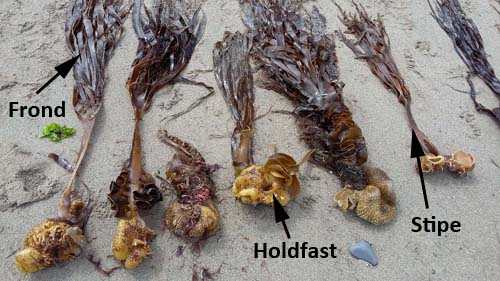
You may find entire plants on the wrack line, or parts of the algae that have been dislodged from the rocks and broken up in the surf.
Kelp holdfasts (the root like structure that attaches the seaweed to the rocks) are a common sight on the wrack line, especially after a storm. You may also find stipes (seaweed stalks) and fronds (seaweed leaves).
Check out the video below to see what kelp looks like underwater.
Red Seaweeds contain pigments which allow them to trap light at much greater depths than brown and green seaweeds and some species even live in the deep ocean. You’ll generally see them growing on the lower part of the rocky shore.
You may also find red seaweed washed up on the wrack line, although the plants may have lost their distinctive color at this stage.
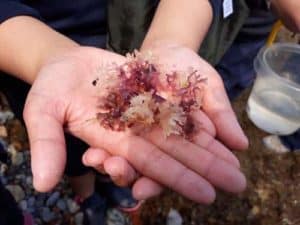
Some red seaweed species have also been harvested by man for centuries. For example, Carrageen or Irish Moss (Chondrus crispus) has been used traditionally as a remedy for coughs and chest infections. It’s also still used as a gelling agent in cooking.
Dillisk (Palmaria palmata) is another favorite, eaten dried as crisps or boiled in milk as a tasty and nutritious sea vegetable. In the 18th Century, Irish immigrants in North America used to have small bags of this seaweed sent to them from home, even though it has always grown off the Atlantic shores of the US.
Can you eat seaweeds washed up on the beach?
We advise against eating seaweed that has been washed up on the beach. Like a lettuce that has been picked, the plant will only remain fresh for a limited time after it has been dislodged from its base on the rocks. You also need to be sure that the seaweed you consume has been growing in an area with excellent water quality and this requires specialist knowledge and experience.
If you’d like to try some seaweed, we recommend that you purchase it from a reputable harvester.
Fish
You may also come across dead fish while you are beachcombing, including skulls and skeletons. Check out the video below by the Harvard Museum of Natural History. It describes the various parts of a bony fish skeleton.
In some parts of the world, there are even fish species that can be found alive on the beach! For example, the Mudskipper has modified gills that are able to absorb oxygen out of water. The species also uses its fins to move up the shore.
Sea Turtles
Sea Turtles are cold blooded marine reptiles that spend most of their time out at sea, although they do come onto land to nest and lay their eggs. They may also be stranded on the shore when they have died or if they have become ill.
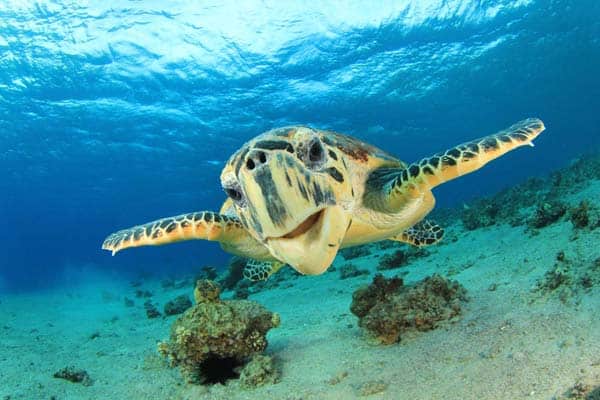
Sea Turtles may follow ocean currents when they are migrating to nursery areas or feeding hotspots. However, sometimes difficult conditions at sea can push the turtles off track, causing them to lose their way. Many live strandings of sea turtles involve animals that have been disrupted in this way. The turtles may be disorientated and/or ill with pneumonia when they’re found on the beach.
The vast majority of Sea Turtle species are adapted to live in warmer waters, the exception being the Leatherback Turtle. Leatherbacks are able to regulate their body temperature so that they can visit colder climes. They migrate to Ireland’s Atlantic Ocean each summer to feed on jellyfish.
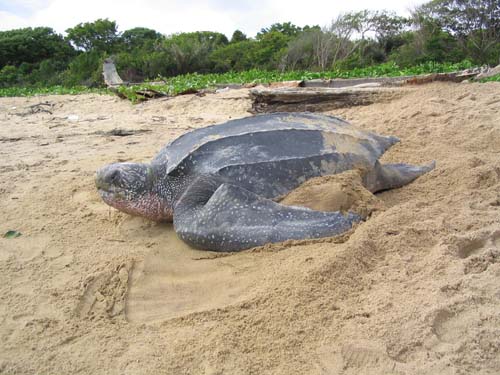
Warm water species, such as the Green Turtle, Loggerhead Turtle, Hawksbill Turtle and Kemp Ridley Turtle can also sometimes be found stranded on coastlines in the north east Atlantic.
Seabirds
Many species of seabird either feed or nest on the shore so it’s not surprising that birdwatching has always been a popular activity for nature lovers visiting the coast. It’s also not uncommon to find the remains of birds that have died and washed up on the beach.
Many seabird carcasses that beachcombers come across are likely to have died of natural causes. However, it is becoming more common for citizen scientists to report seabirds that have been fatally impacted by human activities, such as plastics pollution and climate change.
For example, in the Gulf of Alaska in North America, a worrying number of dead seabirds have been washed ashore in recent years. Scientists consider that these massive die offs (also known as wrecks) are most likely associated with warmer areas of the ocean known as blobs. These blobs, which are becoming more common due to climate change, result in a reduction in the plankton and small fish that many seabirds depend on for food.
Marine Mammals:
Whales, Dolphins and Porpoises
When a whale, dolphin or porpoise dies, the body may be washed up on the beach. These animals may also come in close to shore when they are sick and unfortunately they can sometimes be stranded alive.
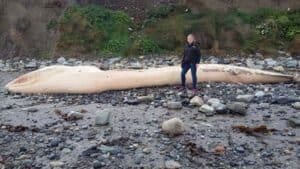
Whales, dolphins and porpoises are mammals, just like humans, and although it may seem unlikely, we share much of the same biology. Like us, these animals breathe air, suckle their young with milk and have hair on their bodies at some stage during their lifetime. They also give birth to live young (called calves).
The scientific word for whale, dolphins and porpoises is cetacean (pronounced sa tay shun), or they may simply be referred to as marine mammals.
It’s important to know what to do if you find a stranded cetacean and you can check out our advice here.
Seals
It’s not uncommon for beachcombers to come across live seal pups on the beach during pupping season in some countries. Seals need to haul out on land in order to sleep and take care of their young, so it’s absolutely normal for a live seal or a seal pup to be on the beach.
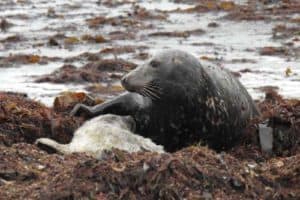
Seal Mums also leave their pups regularly while they are searching for food or just taking a break, so the pup may be on its own for a few hours before it is time for its next feed. However, it’s important to know what to do if you find a seal pup on a busy beach, as it may be in danger from human disturbance. There is also the chance that you may come across a pup that has been injured or abandoned by its mother for some reason.
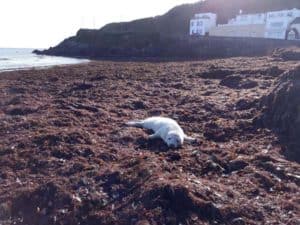
Communities around the world are starting to understand the importance of wildlife on our coasts and you might like to read the story about how everyone came together to take care of a little seal pup in trouble on Ireland’s east coast. It’s a great example of people power!
